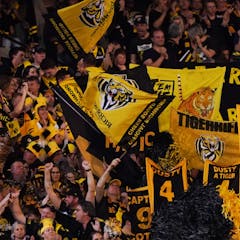
Articles on Australian rules football
Displaying all articles

Discovery of AFL founder Tom Wills’ involvement in the mass murder of Aboriginal people has made it clear truth telling about Australia’s history is needed before any reconciliation can happen.

The AFL Grand Final is more than a physical contest between professional athletes: it is a day we collectively make meaning, and create culture.

Barracking has been a colourful and controversial part of Australian Rules football since the game’s inception. Now, the AFL is trying to maintain order – and fans are irate.

The AFLW has come a long way in a short time. But amid calls for even faster expansion, more games and a longer season, it pays to remember that in footy you shouldn’t go too hard, too early.

Primary prevention programs with a footballing focus aim to change behaviours and attitudes among men towards women.

There is still a place in a sport that remains connected to communities.

Between the 1830s and the 1850s, hundreds of Indigenous warriors and dozens of British settlers were killed across south-east Australia. Echoes of that conflict recur in Aussie rules.

For Indigenous people, refusal is a powerful act of sovereignty. In Grand Final week, it’s timely to reflect on Adam Goodes’ refusal to accept racism in football or an official send off when he retired - and the repercussions of his stance, a year on.

The AFL draws the biggest crowds in the country and its growth has been driven by female fans being drawn to the game and sticking with it as they get older.
